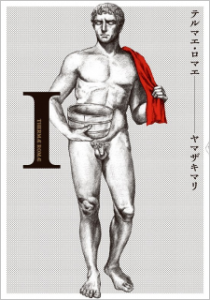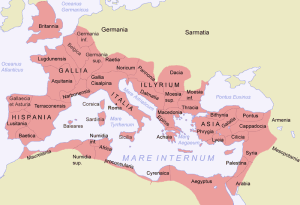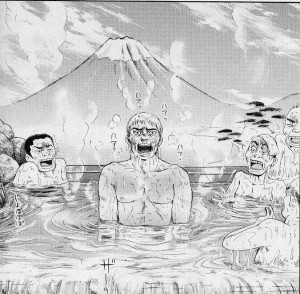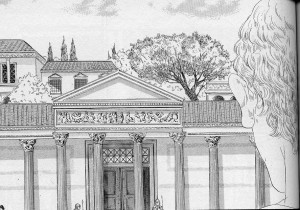All Roads Lead to Thermae Romae
When most people think of Japan, they have a relatively limited cultural palette from which to chose. Samurai, sumo, wacky mascots, big-eyed anime characters, shrines…and baths. Japanese baths are, to many Westerners, an exotic mix of hedonistic luxury, voyeuristic public nudity and, (because we all watched James Clavell’s Shogun mini-series when we were young,) an indication of how civilized the Japanese are.
But the Japanese are hardly the only culture to revel in the various joys of bath-taking. One of the most famous cultures to embrace and refine the architecture of bathing was the Romans. Roman bath structures have been found everywhere the Romans themselves held sway. At their peak of power, this meant that Roman bath-taking was a cultural relic being spread over huge swathes of Europe, the Mediterranean and North Africa and AsiaMinor.
Roman baths are amazingly sophisticated things. In the north of Britain I visited a bath substructure that had survived many millennia, more invasions than you can imagine and was still in good enough shape that you could see how water was brought in, heated, circulated and drained. I find Roman baths amazing and fascinating. And, clearly, so does Yamazaki Mari, creator of one the strangest, yet most charming manga I have ever read, Thermae Romae.
Thermae Romae is set in 129 AD, during the reign of Emperor Hadrian, when the Roman empire was at relative peace, under an Emperor who saw building and economic expansion as a better use of Roman money than war. Lucius Modestus is an architect of baths. His friend Marcus is a sculptor and they are both moderately successful men. Lucius is young enough that his reputation has room to grow.
While Lucius and Marcus are relaxing in a public bath, Lucius finds himself drawn under the water, through a water tunnel deep underground, only to rise out of the water once again…in a public bathhouse in 21st century Japan. If this seems wackadoodle to you, that’s only because it is. And it makes a rollicking good yarn every time.
In every chapter, Lucius is confronted by a conceptual problem – how to make an outside bath, how to create a better atmosphere in a public bath, how to please a wealthy, but aesthetically challenged patron, how to create a bath for soldiers in camp with no running water? And in each chapter, Lucius dives under the water, finds inspiration in a Japanese bathing concept and returns to Rome where he blows the Romans out of the water, as it were, with his amazing ideas.
In between chapters, Yamazaki discusses and shows photos of actual ruins of Roman baths that contain these concepts – everything from posters of popular gladiators on the wall to makeshift bathing contraptions in military camps.
The art in Thermae Romae is part of its charm. Lucius is drawn to resemble a Roman statue of a mature man. Rome itself is rendered with accuracy and sophistication.
Japanese characters are drawn with slight caricature, but recognizably to Western eyes as “Asian,” which sets this manga apart from the big-eyes crowd.
The art is attractive, but what keeps me reading is the fact that Lucius is a fantastic character. As his experiences in Japan become more normal to him, he begins to seek out the stimulation and bring home more ideas. But he’s still human and his fame and fortune comes at a price – he loses his wife, who is tired of being left behind. (And those rumors that Emperor Hadrian favors him aren’t helping any either….)
Thermae Romae runs in Enterbrain’s Comic Beam, a magazine that has the tagline “…a MAGAZINE for the COMIC FREAKS” in English on every cover. This comic is for a sophisticated, adult manga-reading audience. Comic Beam is most notable here in the west for publishing Wandering Son by Takako Shimura, currently published by Fantagraphics. Appreciation for Yamazaki’s eclectic story is not limited to comic freaks, she has won the 3rd Manga Taisho Award and the 14th Tezuka Osamu Cultural Prize for this work. A live-action movie has just been announced for this title, as well…although it looks like they are going with an all-Japanese cast, which will dilute the visual impact of the story. The visual contrast between Ancient Rome and the Romans and Modern Japan and the Japanese is the one of the main strengths of the art.
Yamazaki’s story, characters and art combine to create a completely unique, complex and fascinating story. At three volumes so far , Thermae Romae is the kind of manga it’s worth learning Japanese to be able to read




This is going to sound unfair, but when I read the concept of the manga, I can’t help but think Ah ! One of those manga about how Japanese people are secretly at the origin of everything worthwhile, like those awful Buronson manga where Genghis Khan is actually a Japanese scholar from the future (Oh roh), or all the really heroic and honourable characters of the Warring States period are secretly Japanese (Lord)…
I know it’s just supposed to be a fun trope, and I don’t see the editors of Comic Beam lowering themselves to that kind of nationalism, but still, I think it kind of illustrates how “self-centered” Japanese culture often is.
(Come to think about it, American people tend to do that too, don’t they ? ;)
@Josselin – I hear you, but in this one case, I’m going to give them a bye. It’s too amusing and light-heartedly crafted a series to be intentionally “nationalistic.”
But yes, Americans…and every country really…do much the same thing. We do it as humans too – no aliens ever seem to want to attack non-human inhabited worlds, do they? ;-)
Pingback: Shutterbox is back, new Matsumoto, and parsing the DMG contract « MangaBlog
Pingback: atlanticanime.com » Shutterbox is back, new Matsumoto, and parsing the DMG contract
Pingback: Shutterbox and The Skull Man: A Week of Manga News » MTV Geek